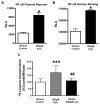Heme oxygenase-1 inhibits pro-oxidant induced hypertrophy in HL-1 cardiomyocytes
- PMID: 19244544
- PMCID: PMC2787409
- DOI: 10.3181/0810-RM-312
Heme oxygenase-1 inhibits pro-oxidant induced hypertrophy in HL-1 cardiomyocytes
Abstract
Aims: Reactive oxygen species (ROS) activate multiple signaling pathways involved in cardiac hypertrophy. Since HO-1 exerts potent antioxidant effects, we hypothesized that this enzyme inhibits ROS-induced cardiomyocyte hypertrophy.
Methods: HL-1 cardiomyocytes were transduced with an adenovirus constitutively expressing HO-1 (AdHO-1) to increase basal HO-1 expression and then exposed to 200 microM hydrogen peroxide (H2O2). Hypertrophy was measured using 3H-leucine incorporation, planar morphometry and cell-size by forward-scatter flow-cytometry. The pro-oxidant effect of H2O2 was assessed by redox sensitive fluorophores. Inducing intracellular redox imbalance resulted in cardiomyocyte hypertrophy through transactivation of nuclear factor kappa B (NF-kappaB).
Results: Pre-emptive HO-1 overexpression attenuated the redox imbalance and reduced hypertrophic indices. This is the first time that HO-1 has directly been shown to inhibit oxidant-induced cardiomyocyte hypertrophy by a NF-kappaB-dependent mechanism.
Conclusion: These results demonstrate that HO-1 inhibits pro-oxidant induced cardiomyocyte hypertrophy and suggest that HO-1 may yield therapeutic potential in treatment of.
Figures








Similar articles
-
5-aminolevulinic acid combined with sodium ferrous citrate ameliorates H2O2-induced cardiomyocyte hypertrophy via activation of the MAPK/Nrf2/HO-1 pathway.Am J Physiol Cell Physiol. 2015 Apr 15;308(8):C665-72. doi: 10.1152/ajpcell.00369.2014. Epub 2015 Feb 4. Am J Physiol Cell Physiol. 2015. PMID: 25652453
-
Heme oxygenase-1 inhibits angiotensin II-induced cardiac hypertrophy in vitro and in vivo.Circulation. 2004 Jul 20;110(3):309-16. doi: 10.1161/01.CIR.0000135475.35758.23. Epub 2004 Jun 28. Circulation. 2004. PMID: 15226216
-
Interaction of heme with nitroxyl or nitric oxide amplifies heme oxygenase-1 induction: involvement of the transcription factor Nrf2.Cell Mol Biol (Noisy-le-grand). 2002 Dec;48(8):885-94. Cell Mol Biol (Noisy-le-grand). 2002. PMID: 12699247
-
The heme synthesis and degradation pathways: role in oxidant sensitivity. Heme oxygenase has both pro- and antioxidant properties.Free Radic Biol Med. 2000 Jan 15;28(2):289-309. doi: 10.1016/s0891-5849(99)00223-3. Free Radic Biol Med. 2000. PMID: 11281297 Review.
-
Heme oxygenase-1: redox regulation of a stress protein in lung and cell culture models.Antioxid Redox Signal. 2005 Jan-Feb;7(1-2):80-91. doi: 10.1089/ars.2005.7.80. Antioxid Redox Signal. 2005. PMID: 15650398 Review.
Cited by
-
The coordinated increased expression of biliverdin reductase and heme oxygenase-2 promotes cardiomyocyte survival: a reductase-based peptide counters β-adrenergic receptor ligand-mediated cardiac dysfunction.FASEB J. 2011 Jan;25(1):301-13. doi: 10.1096/fj.10-166454. Epub 2010 Sep 27. FASEB J. 2011. PMID: 20876213 Free PMC article.
-
Dystrophic muscle improvement in zebrafish via increased heme oxygenase signaling.Hum Mol Genet. 2014 Apr 1;23(7):1869-78. doi: 10.1093/hmg/ddt579. Epub 2013 Nov 13. Hum Mol Genet. 2014. PMID: 24234649 Free PMC article.
-
Differential Effects of β-Blockers, Angiotensin II Receptor Blockers, and a Novel AT2R Agonist NP-6A4 on Stress Response of Nutrient-Starved Cardiovascular Cells.PLoS One. 2015 Dec 21;10(12):e0144824. doi: 10.1371/journal.pone.0144824. eCollection 2015. PLoS One. 2015. PMID: 26691397 Free PMC article.
-
FGF23 is a novel regulator of intracellular calcium and cardiac contractility in addition to cardiac hypertrophy.Am J Physiol Endocrinol Metab. 2013 Apr 15;304(8):E863-73. doi: 10.1152/ajpendo.00596.2012. Epub 2013 Feb 26. Am J Physiol Endocrinol Metab. 2013. PMID: 23443925 Free PMC article.
-
Evolving Strategies for Use of Phytochemicals in Prevention and Long-Term Management of Cardiovascular Diseases (CVD).Int J Mol Sci. 2024 Jun 4;25(11):6176. doi: 10.3390/ijms25116176. Int J Mol Sci. 2024. PMID: 38892364 Free PMC article. Review.
References
-
- Frey N, Olson EN. Cardiac hypertrophy: the good, the bad and the ugly. Ann Rev Physiol. 2002;65:45–79. - PubMed
-
- Swynghedauw B. Molecular mechanisms of myocardial remodeling. Physiol Rev. 1999;79:215–262. - PubMed
-
- Sawyer DB, Siwik DA, Xiao L, Pimentel DR, Singh K, Colucci WS. Role of oxidative stress in myocardial hypertrophy and failure. J Mol Cell Cardiol. 2002;34:379–388. - PubMed
Publication types
MeSH terms
Substances
Grants and funding
LinkOut - more resources
Full Text Sources

